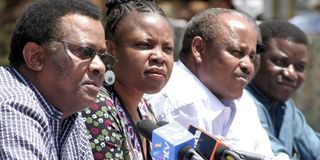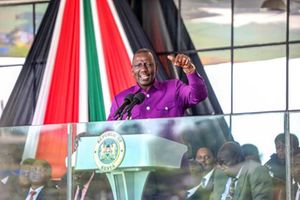How lawmakers mutilated draft in Naivasha

The Committee of Experts at a press briefing in Naivasha in 2009.
What you need to know:
- But the man who chaired PSC – Abdikadir Mohamed – does not believe his team mutilated the CoE proposals.
- He says CoE was a creation of Parliament and that its constitutive Act did not give it the final say on the document produced.
- As the 2010 Constitution reaches its 10th year, the value of the Naivasha retreat to the process of delivering the document is still being debated.
Had the Committee of Experts (CoE) had its way during the review of the constitution, the country would be having a hybrid system of government exactly as recommended by the initial Building Bridges Initiative (BBI) task force report.
It means Kenya would be having an elected president, a prime minister and two deputy prime ministers elected by parliament.
In addition, the Cabinet would be made up of professionals and MPs, as the BBI proposes.
Further, the Harmonised Draft Constitution which was the product of the CoE, sought to entrench in the constitution the office of the leader of the official opposition in parliament, complete with a shadow cabinet and a secretariat.
However, the proposals and others, would be cast aside once the political class, through the Parliamentary Select Committee (PSC) on Constitutional Review, took charge.
PSC members met at Great Rift Valley Lodge, Naivasha as they thrashed out the document that would become the 2010 Constitution of Kenya amid pressure from major political formations – the Orange Democratic Movement (ODM) and the Party of National Unity (PNU) – religious groups, the international community and Kenyans in general.
Divided opinion
The process and product of the Naivasha talks PSC continues to divide opinion.
Mr Nzamba Kitonga, who chaired CoE, says the recommendations in the initial report of the BBI task force vindicates his team’s proposals and that PSC was not justified in discarding them.
“Indeed, it is the mistakes of the Naivasha PSC which have come to haunt Kenya. The harmonised draft contained all the provisions of the expanded Executive contained in BBI. These provisions were intended to create national cohesion and harmony,” Mr Kitonga says.
He adds that Naivasha mutilated the Senate and designated it as the lower House against experience all over the world.
The original proposal was to let bills flow from the National Assembly to the Senate for approval then to the President for assent. As it is, the Senate was retained with a narrow mandate of just overseeing devolution.
It is a view shared by Prof Musili Wambua of the University Of Nairobi School of Law.
A lot of leeway
According to Prof Wambua, who was a member of the Constitution of Kenya Review Commission (CKRC), the problems being experienced with the Constitution are due to the fact that politicians had a lot of leeway in the process, mainly in Naivasha.
He says the CoE’s Harmonised Draft was largely a reflection of the Bomas Draft, “which reflected the views of a majority of Kenyans”.
“We gave too much leeway to politicians. They did not look at the long term,” he said.
But the man who chaired PSC – Abdikadir Mohamed – does not believe his team mutilated the CoE proposals.
He says CoE was a creation of Parliament and that its constitutive Act did not give it the final say on the document produced.
“The perception that these were the good guys who wanted to get the best constitution for the country and the PSC was out to kill their proposal is not correct,” Mr Mohamed told the Nation.
He added that CoE had no business dwelling much on contentious issues like the system of government to be adopted.
“The idea was to deliver a politically settled document before taking the country to the referendum,” Mr Mohamed said.
Political settlement
“Without Naivasha, we would not be having this Constitution. We did not fight in 2007 and 2008 or lose the 2005 referendum because we did not have a good document. On both occasions, we did not have a political settlement. Therefore, Naivasha was important.”
As debate on whether or not to amend the Constitution 10 years after it was promulgated, Prof Wambua says this could have been avoided if the hybrid system of government proposed by Bomas and the CoE had been allowed.
“It was a big mistake to go the presidential route. What we should have been doing was to deconcentrate power from the presidency,” Prof Wambua said.
“If that was done properly, we would not be going back to the Bomas Draft which is what we are doing.”
As the 2010 Constitution reaches its 10th year, the value of the Naivasha retreat to the process of delivering the document is still being debated. For those who believe Naivasha was critical, the key argument is that it offered an avenue for political settlement which would otherwise would not have been possible through CoE.
“The idea then was to sit, discuss, compromise and agree on the way forward,” Mr Mohamed said.
Recalling the Naivasha days, Mr Mohamed says Eldoret North MP William Ruto and his Gichugu counterpart Martha Karua were the most active PSC members.
“They would be up late when the others were asleep,” he recalls.



